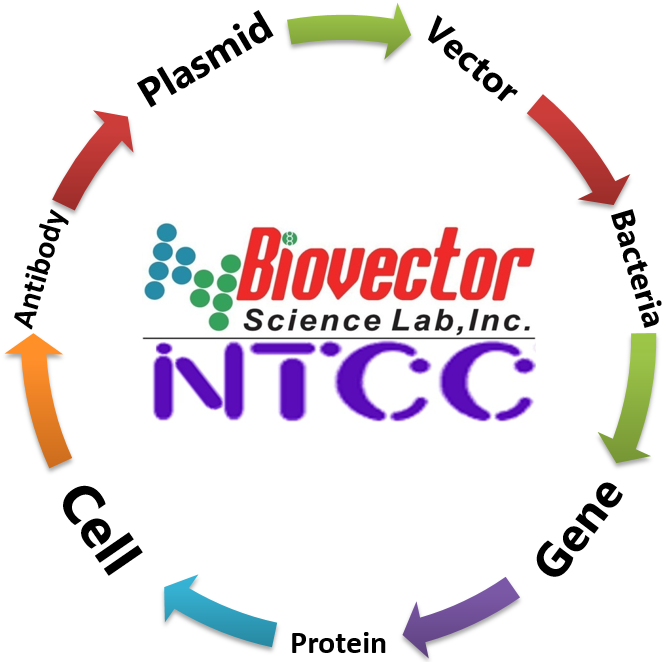pCDNA3.1-EGFP①哺乳動(dòng)物細(xì)胞綠色熒光表達(dá)載體質(zhì)粒
- 價(jià) 格:¥19862
- 貨 號(hào):pCDNA3.1-EGFP①哺乳動(dòng)物細(xì)胞綠色熒光表達(dá)載體質(zhì)粒
- 產(chǎn) 地:北京
- BioVector NTCC典型培養(yǎng)物保藏中心
- 聯(lián)系人:Dr.Xu, Biovector NTCC Inc.
電話:400-800-2947 工作QQ:1843439339 (微信同號(hào))
郵件:Biovector@163.com
手機(jī):18901268599
地址:北京
- 已注冊(cè)
啟動(dòng)子: CMV promoter
復(fù)制子: pUC ori,F(xiàn)1 ori
終止子: BGH poly(A)signal
質(zhì)粒分類(lèi): 哺乳系列質(zhì)粒;哺乳表達(dá)質(zhì)粒;pCDNA系列質(zhì)粒
質(zhì)粒大小: 6173bp
質(zhì)粒標(biāo)簽: C-EGFP
原核抗性: 氨芐青霉素Amp(100μg/ml)
篩選標(biāo)記: 新霉素Neo/G418
克隆菌株: DH5α等大腸桿菌
培養(yǎng)條件: 37℃,有氧,LB
表達(dá)宿主: 293T等哺乳細(xì)胞
培養(yǎng)條件: 37℃,5%CO2
誘導(dǎo)方式: 無(wú)需誘導(dǎo)
5'測(cè)序引物: pCDNA3.1-F(CTAGAGAACCCACTGCTTAC)
3'測(cè)序引物: pCDNA3.1-R(TAGAAGGCACAGTCGAGG)
質(zhì)粒簡(jiǎn)介
pCDNA3.1-EGFP質(zhì)粒是將EGFP基因克隆進(jìn)入pCDNA3.1載體所得,設(shè)計(jì)用于哺乳動(dòng)物宿主中的高水平穩(wěn)定和瞬時(shí)表達(dá)。大多數(shù)哺乳動(dòng)物細(xì)胞可以進(jìn)行高水平的穩(wěn)定和非復(fù)制性瞬時(shí)表達(dá)。人類(lèi)巨細(xì)胞病毒立即早期(CMV)啟動(dòng)子,用于在廣泛哺乳動(dòng)物細(xì)胞中的高水平表達(dá)。在潛伏感染SV40或表達(dá)SV40大T抗原(例如COS-1,COS-7)的細(xì)胞系中的異常復(fù)制。
The GFP in pcDNA3.1-eGFP stands for green fluorescent protein. Deoxyribonucleic acids (DNAs) are typically made up of protein, so it makes sense for a special protein to make up a specific type of DNA add-gene such as the pcDNA3.1.although other means besides cloning would also be openly discussed. In this study, a detailed overview of how pcDNA-eGFP can be produced through cloning is done thanks to the use of secondary sources; a proper review of the pcDNA3.1-eGFP is first carried out to understand this compound. Afterward, the importance of a vector in the cloning process is looked at in detail and finally the cloning system is covered extensivel GFP proteins are generally composed of 238 amino acids with molecular masses of around 26.9 KD [1] and are typically used in the field of molecular biology as one of the many reporter genes. Basically, a reporter gene is a type of gene that researchers, especially in laboratory experiments, use to attach to a pre-specified sequence of the gene (oftentimes an experimental one) such as that of bacteria, plants, animals, and cell cultures. Some of the criteria that researchers use when selecting a reporter gene include, but may not be limited to, having easily identifiable and selectable markers and their ability to introduce changes that tend to be easily spotted under certain conditions. When conducting laboratory experiments in molecular biology, it would be important for researchers to know the different variables involved and the impact that they create on the experimental environment. Therefore, it makes sense to select reporter genes that possess these qualities such as the GFP [1]. In previously published studies involving the use of GFPs, including but not limited to pcDNA3.1, it has been common for researchers to introduce the GFP gene into cells using vector-based systems. In some cases, the researchers also used recombinant viruses (attaching the GFP to them). Being used as a reporter protein, the location of the target protein can be easily identified and expressed. However, in many of the laboratory experiments, the selection market of the GFPs used was not specific enough and there is often no selection market to normalize the transfection among other reactions.
質(zhì)粒圖譜
BioVector NTCC質(zhì)粒載體菌種細(xì)胞蛋白抗體基因保藏中心
電話:+86-010-53513060
網(wǎng)址:www.biovector.net
您正在向 biovector.net 發(fā)送關(guān)于產(chǎn)品 pCDNA3.1-EGFP①哺乳動(dòng)物細(xì)胞綠色熒光表達(dá)載體質(zhì)粒 的詢(xún)問(wèn)
- 公告/新聞




